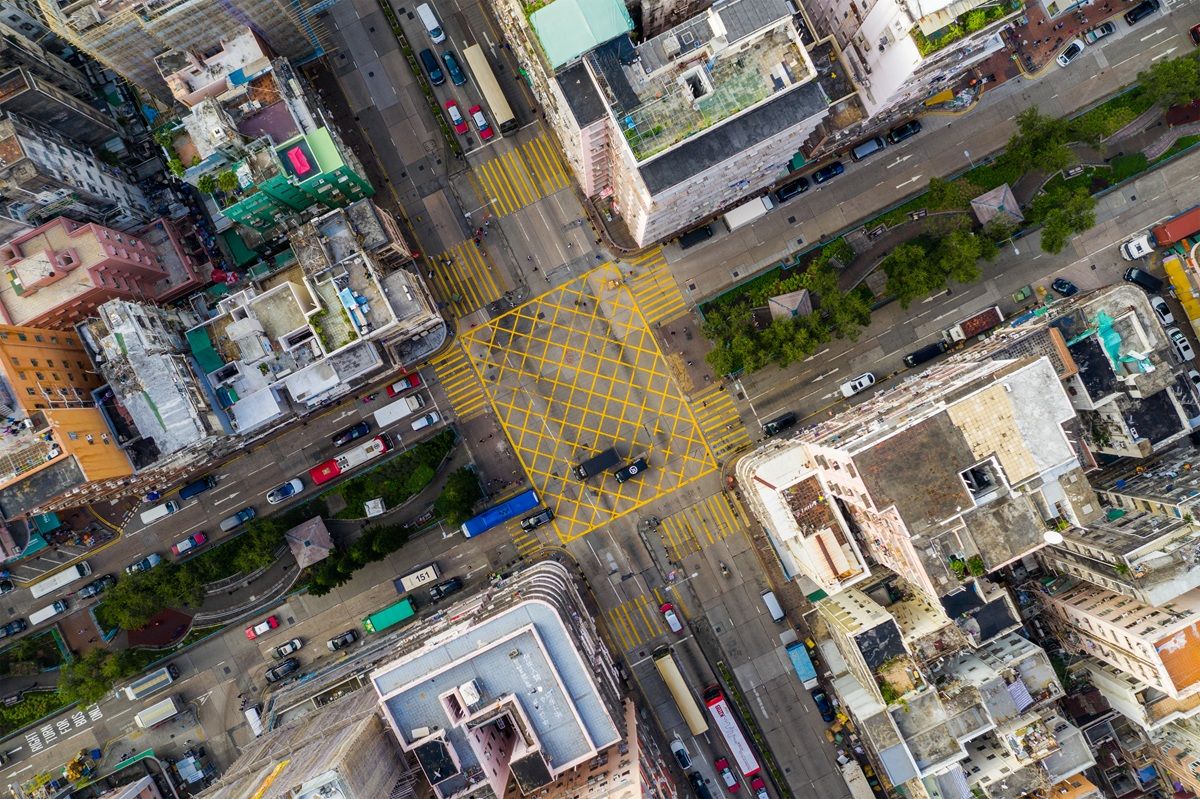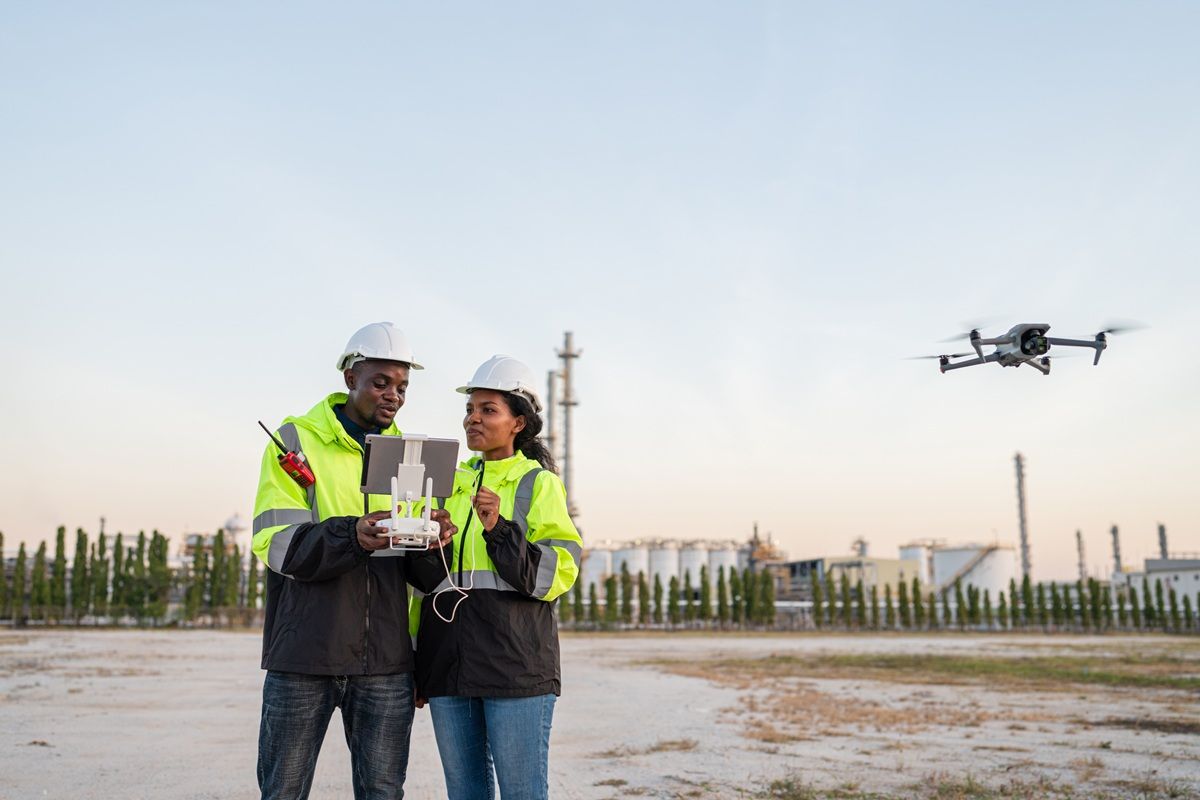Photogrammetry is a field of science and technology that has, for decades, supported the process of creating detailed, multidimensional maps of specific areas. It involves reconstructing the shape, size, and spatial relationships of objects based on photographic images known as photograms. The first photogrammetric images were taken from a tethered balloon in Paris between 1858 and 1859.
Today, photogrammetry is accessible to everyone – thanks to SkyeBrowse technology. All you need is a drone and a few basic steps. Let’s explore what photogrammetry is and how you can use it in practice.
Contents:
- What Is Photogrammetry and How Does It Work?
- What are SkyeBrowse photogrammetry and videogrammetry? How do they differ in practice?
- Applications of photogrammetry in public safety – From scene documentation to crisis management
- Photogrammetry – What input data and equipment are needed?
What Is Photogrammetry and How Does It Work?
Photogrammetry is the science and technique of obtaining accurate measurements and information about objects and spaces from images, and then using those images to create 2D maps (such as orthomosaics) or 3D models. Simply put, it involves photographing a space from multiple viewpoints, then using algorithms to merge those photos and reconstruct the real geometry of an object or terrain. This approach forms the foundation of many modern processes in areas like GIS, CAD, and technical inspections.
The applications of photogrammetry are extremely broad. It’s used in topography, engineering, and construction, as well as in fields such as public safety, cultural heritage preservation, and geology. For example, engineers can use 3D models to analyze building structures, while emergency services can recreate accident or crime scenes. Archaeologists rely on photogrammetry to document excavation sites with precision and without physical interference.

Mechanically speaking, photogrammetry often relies on the concept of stereo vision or triangulation. By capturing two or more images of the same scene from different positions, it’s possible to identify common points (features) in each image and calculate their actual 3D coordinates through geometry. This process generates a point cloud, a 3D mesh, an orthomosaic, or other useful spatial products. There are generally two main approaches:
- Aerial photogrammetry – images captured from a drone or aircraft over large areas.
- Close-range photogrammetry – images taken manually or by a low-flying drone close to an object, such as a building or installation.
Aerial photogrammetry is ideal for 3D mapping of terrain, large-scale engineering projects, and infrastructure inspections. Close-range photogrammetry, on the other hand, is widely used in inventory documentation, architecture, and incident reporting.
By incorporating photogrammetry, organizations can integrate 3D data or orthomosaics directly into GIS/CAD or inspection workflows. It’s a key component of modern projects that require precise measurement, documentation, analysis, or simulation. As a result, work becomes faster, more accurate, and data more accessible and actionable.
Want to experience photogrammetry firsthand? Try SkyeBrowse technology. Within just minutes, you can complete a project that would traditionally take hours using conventional photogrammetry methods. Learn more today – and start for free.
What are SkyeBrowse photogrammetry and videogrammetry? How do they differ in practice?
In traditional photogrammetry, the input data consists of hundreds or even thousands of drone or camera images – often captured along a preplanned flight path with high image overlap. This method provides excellent accuracy but also requires significant time for both data collection and processing.
In contrast, SkyeBrowse uses a technique called videogrammetry, which is based on analyzing one or more short video sessions captured by a camera or drone. The software automatically extracts individual frames from the video and uses them to build a 3D model or orthomosaic.
The result? A dramatically simplified and accelerated process – reducing what once took hours or days to just a few minutes, without compromising data quality.
This means that if a scene is time-critical – for example, during incident documentation, emergency response, or urgent inspection – videogrammetry powered by SkyeBrowse offers a clear advantage. The shorter time from flight to finished 3D model allows users to move quickly from data capture to analysis or action.
It’s worth noting that on larger areas or in less time-sensitive scenarios, traditional photogrammetry still has its place – especially when the highest accuracy and the use of Ground Control Points (GCPs) are required.
Importantly, SkyeBrowse fully automates the entire process. The user focuses on the task itself (e.g., flying over a scene or recording a video), while the 3D mapping software handles the rest – including video analysis, flight path reconstruction, 3D model generation, and data processing. This means operators require minimal training, and workflows can be completed much faster.
This is the core advantage of SkyeBrowse 3D mapping software for emergency services, engineers, and inspection teams.
Learn more about photogrammetry. Visit the “Use Cases” section on the SkyeBrowse website to explore specific scenarios where rapid videogrammetry has helped professionals carry out complex missions quickly and safely.
Applications of photogrammetry in public safety – From scene documentation to crisis management
Photogrammetry is gaining increasing recognition in the field of public safety — for example, in documenting traffic accidents or crime scenes. It enables digital documentation of an incident site in the form of 2D orthomosaics or 3D models, significantly reducing scene closure time and allowing for a quicker reopening of the area to traffic. Traditional methods, such as total stations or manual measurements, are time-consuming, while using photogrammetry in accident documentation provides measurable benefits. With this technology, investigators can continue to work on a scene even after it has been cleared, as all relevant data has already been digitally captured.
Photogrammetry in specific scenarios
Accident Scene Documentation — for example, a pipeline rupture or a multi-vehicle collision. By using a drone, responders can perform a quick flight to collect visual data and then generate maps or 3D models that serve as evidence in legal proceedings or as a basis for forensic reconstruction and analysis.
Situational Sketches and Orthomosaics — for first responders or police, the ability to quickly map the scene helps organize entry and exit routes, safety zones, and evacuation points. Since the site often needs to be cleared rapidly, a digital map provides valuable spatial awareness, improving coordination and operational planning during the response phase.
Crisis Management After Disasters — such as hurricanes, floods, or wildfires. In large-scale emergencies where response time is critical, drone-generated 3D models or orthomosaics allow agencies to assess damage, determine operational priorities, and share real-time visual data across multiple teams.
 Beyond outdoor environments, photogrammetry also plays a crucial role in indoor scene documentation — including schools, offices, warehouses, crime scenes (e.g., shootings or explosions), and critical infrastructure facilities. Thanks to SkyeBrowse technology — which converts drone or handheld video footage into a 3D model automatically — responders can quickly create accurate reconstructions without the need for laser scanners or days of manual measurements. This minimizes disruption to facility operations, shortens on-site procedures, and helps teams prepare for post-incident analysis more effectively.
Beyond outdoor environments, photogrammetry also plays a crucial role in indoor scene documentation — including schools, offices, warehouses, crime scenes (e.g., shootings or explosions), and critical infrastructure facilities. Thanks to SkyeBrowse technology — which converts drone or handheld video footage into a 3D model automatically — responders can quickly create accurate reconstructions without the need for laser scanners or days of manual measurements. This minimizes disruption to facility operations, shortens on-site procedures, and helps teams prepare for post-incident analysis more effectively.
It’s also important to highlight the evidentiary value of such data. A 3D model or orthomosaic serves as a permanent digital record of the scene, which can be shared with investigators, prosecutors, forensic experts, or infrastructure managers. The digital reconstruction minimizes the risk of evidence loss, allows for precise re-examination of the site at a later stage, and increases the overall credibility of evidence in court proceedings.
SkyeBrowse makes it easy to share 3D models with authorized teams and to integrate data with GIS/CAD platforms or digital evidence repositories. This leads to better inter-agency collaboration, greater efficiency, and faster response times — key benefits for modern public safety operations.
Photogrammetry – What input data and equipment are needed?
In traditional photogrammetry, the required inputs include a series of overlapping photos captured with proper framing and coverage, consistent flight parameters (such as altitude and flight path), and ground control points (GCPs) to ensure high accuracy. Standard requirements also include sufficient image resolution (at least 70% overlap between images), flight planning with a drone, and subsequent processing in photogrammetry software.
SkyeBrowse photogrammetry software offers a simpler process. Input data can come in the form of video (recorded from a drone or handheld camera) instead of hundreds of still images. The platform uses videogrammetry technology, which lowers the entry barrier, accelerates data collection, and enables faster generation of 3D models or orthomosaics. In practice, this means that instead of planning multiple photos, the operator can perform a single smooth flight or record a continuous video, and the system will automatically process the data. The key performance indicator (KPI) becomes the “time from capture to model” — the shorter, the better. SkyeBrowse reports a ready-to-use model within just a few minutes.
Pre-Flight checklist for drone operators
- Check the weather forecast — strong winds, rain, or poor visibility can affect video quality.
- Ensure the airspace is clear and unobstructed — avoid power lines, trees, and buildings, or make sure your planned flight path accounts for them.
- Monitor for RF (radio frequency) interference or GPS signal loss, which can impact the drone’s positioning stability.
- Verify battery levels for both the drone and camera — bring backup batteries if the flight or recording will be extended.
- Review local FAA or state regulations — including pilot certification, Part 107 compliance, and any required flight notifications.
- Prepare your recording equipment — whether using a visual camera or a drone in video mode, check stabilization, resolution, frame rate, and compatibility with the video-to-model processing system.